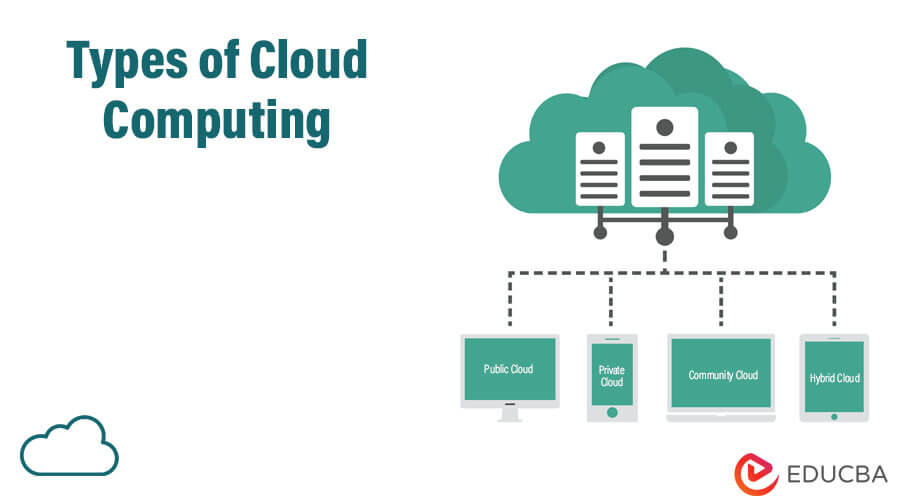
Introduction to Types of Cloud Computing
Service offered via the Internet are generalized as cloud computing and is categorized as IaaS, PaaS, FaaS, and SaaS; it is mainly divided into two types, i.e., Deployment and Service models where the deployment model consists of the cloud computing services like Public Cloud, Private Cloud, Private and Hybrid which is used for applications like blog hosting, creation of a fresh application, Video, and Audio stream, etc.
Types of Cloud Computing
There are mainly two types of Cloud Computing which are as follows:
- Deployment Model
- Service Model
The following kinds of cloud computing may be available based on the three types of deployment models:
- Public
- Community Cloud
- Private
- Hybrid
1. Public Cloud
Third-party suppliers describe the public cloud as computing services provided through the public Internet, making them accessible to those who want to use or buy them. It can be free or on-demand for customers to pay for the cycles, storage, or bandwidth they consume per usage.
Example: Sun Cloud, AWS, Microsoft Azure
2. Community Cloud
A particular group of customers from organizations with shared issues can only use cloud infrastructure. One or more communal organizations, a third party, or a combination thereof can own, operate, manage, and run it.
3. Private Cloud
One organization uses private IT facilities to supply IT services for its specialized use in a private cloud computing system. A single organization operates the cloud infrastructure only. The organization or a third party can run it on-site or off-site. Private cloud terms are often employed interchangeably with the virtual private cloud (VPC). Technically speaking, a VPC (Virtual Private Cloud) is a private cloud that utilizes the infrastructure of a third-party cloud provider, while an inner cloud is enforced.
Example: AWS, VMware
4. Hybrid Cloud
A hybrid cloud is a computer environment incorporating a government and private cloud to share information and apps. Organizations achieve flexibility and the computer capacity of a government cloud for fundamental and insensitive computing functions whilst safe behind a corporate firewall for business-critical apps and information.
Example:
When delicate data is engaged, Federal agencies opt for personal clouds.
The following kinds of cloud computing may be available depending on the type of service model:
- IAAS
- PAAS
- SAAS
- Faas
What is IaaS?
IaaS is a cloud computing model in which companies’ external cloud providers provide and manage virtualized infrastructure for businesses. With IaaS, businesses can outsource Internet-based storage, servers, data centers, and network elements with the same functionality as local infrastructure. Some examples of IaaS’s extensive use include automated policies such as support, clustering, inner networking, restoration, tracking, hosting the site, etc. The provider is responsible for server and storage building, networking of firewalls/security, and physical data centers. The supplier controls server and storage construction, firewall networking, and safety and physical information centers.
What is Paas?
PaaS builds on IaaS. Cloud vendors provide computing resources to create and test apps, including cloud and hardware infrastructure parts, such as middleware and operating systems. In addition to constructing and keeping the required equipment, the PaaS environment allows cloud users to install and house information sets, development instruments, and company assessment software. Some of the main players with a PayPal system include CloudBees, Salesforce.com, Engine, Heroku, Google App, and Bluemix.
What is Saas?
Software as a service (SaaS) is a distribution system of software where a third-party supplier hosts and provides apps to clients over the Internet. The SaaS host application management model is similar to ASP, in which the provider hosts the software of customers and delivers it over the Internet to approved end-users. The provider provides network-based customers with a unique copy of an application specially designed by a provider for the SaaS distribution in the software on-demand SaaS model. All clients implement the universal source code for the application when new functions or functionalities are developed.
What is Faas?
Faas stands for the Function of a server. FaaS brings another layer of PaaS abstraction, making designers fully insulated from everything under their software in the stack. Installation blocks of code in narrow functionality set them to be activated by a specific event rather than the hazards associated with virtual servers, containers, and application runtimes. Until an event happens, FaaS applications don’t consume IaaS resources, lowering the charges.
Uses of Cloud Computing
While you may not be aware that you are now using cloud computing, most of us use an internet service to send e-mail, edit records, watch films, etc. Cloud computing probably makes everything possible behind the scenes. Today, many organizations, from small start-ups to public organizations, use the following technology.
- Create fresh applications and services, save, backup, and retrieve information.
- Blogs and Hosting Websites.
- Video And Audio Stream.
- Provide software services on request.
Conclusion
In this article, we have seen what cloud computing is, the types of Cloud Computing along with their uses, and the different types of service models used in cloud computing.
Recommended Articles
This has been a guide to Types of Cloud Computing. Here we have discussed the different types of cloud computing, uses, and the different service models used. You may also look at the following articles to learn more –


